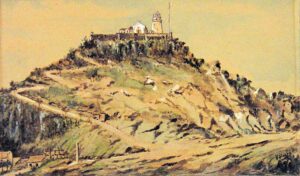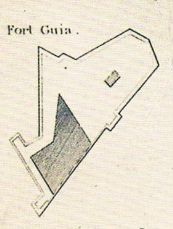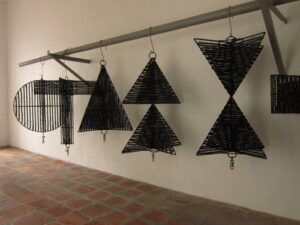Guia – fortress, chapel and lighthouse
by Stuart Braga
Macau in 1835. This picture appeared in Anders Ljungstedt’s book. The three hills are Guia on the right, Monte Fort in the centre and Penha on the left.
More than 300 years ago as mariners approached Macau the first glimpse they had of this tiny European outpost in East Asia was a little chapel perched improbably at the top of a steep hill. After months at sea, perhaps calling at various ports in East Africa and South Asia, sailors were keen to see something familiar. The sight of this European building must have been a considerable thrill. The chapel was dedicated to Our Lady of the Snows in reference to the ancient church built on top of the Esquiline Hill, one of the original Seven Hills of Rome, but is more commonly known as capela de Nossa Senhora da Guia, the chapel of Our Lady of Guidance.
The fortress built around the steep sides of Guia Hill predates the chapel. Guia was already partially fortified by 1622, when the Dutch attempted to seize Macau on the feast day of St. John the Baptist, 24 June. Guia played a significant role in repelling the Dutch, who had landed a little to the North East and began to advance on the city. A shot from Monte fortress set off an explosion in the wagon in which the Dutch had their ammunition, whereupon they retreated in disorder, having sustained many casualties, including most of their officers. Attempting to regroup, they decided to climb Guia Hill to get a better view of their enemy, but their ascent was resisted by a small party of thirty men, whose ferocity and effective use of the high terrain forced the Dutch to abandon this plan. Retreat soon became a rout and the Dutch, who had greatly outnumbered the Portuguese defenders, returned to their base in Batavia.
Thereafter the fortifications were strengthened in earnest. The towering walls and the fort above them were completed in 1638 in the expectation of a renewed Dutch attack. This never happened, but Guia remained a military area until 1976. The completion of the fort was marked by a stone bearing the Portuguese royal arms. This seems to have been an act of defiance by the Macau Council, soon to be known as the Leal Senado, against Spanish authority, since Portugal was under Spanish rule from 1580 until 1640. Beneath the royal arms of Portugal is an inscription, reading, in translation:
THE CITY ORDERED THIS FORT TO BE BUILT AT ITS OWN EXPENSE BY CAPTAIN OF THE ARTILLERY ANTÓNIO RIBEIRO RAIA. IT WAS STARTED IN SEPTEMBER 1637 AND WAS FINISHED IN MARCH 1638, THE GENERAL THEN BEING DA CAMARA DE NORONHA.
This did not mean that the Guia lighthouse was useless. It doubled as a weather station and being on the highest point in Macau, it was in the ideal position for signals warning of approaching typhoons. There were ten signals of different shapes, made of wickerwork and painted black. When severe conditions threatened, these signals were hoisted according to the meteorological outlook. Anything above No. 8 was serious, and No. 10 warned of an approaching catastrophe. This is actually what happened in 1874, when the Great Typhoon devastated Macau, killing thousands of people. Among the many buildings that had to be rebuilt was the lighthouse itself, though the sturdy chapel survived the tempest.
The vast casinos of modern Macau dwarf all its ancient buildings, crowding around them and towering over many. Guia, often neglected and less visited than the other iconic and more accessible World Heritage sites, deserves more attention than it receives.




